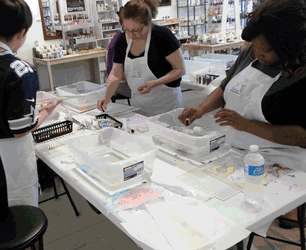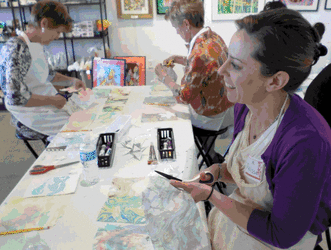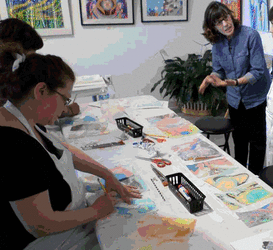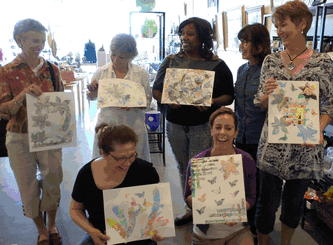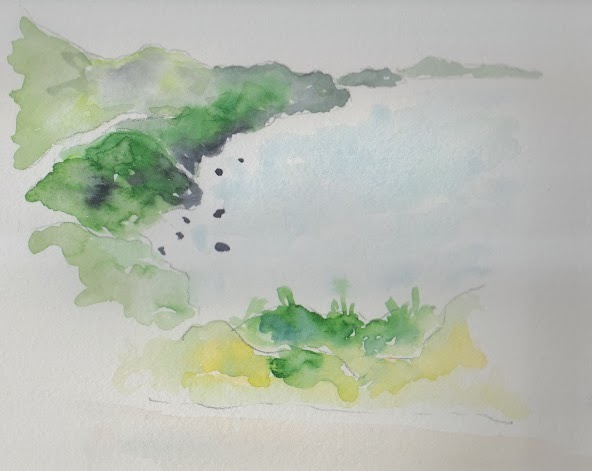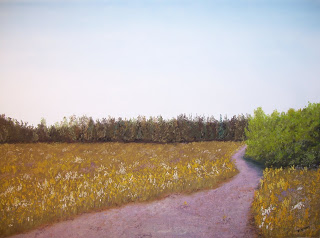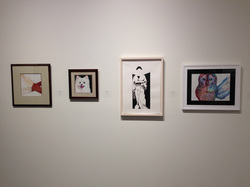 How exciting to exhibit for the first time, and how vulnerable for the artist. Sharing a work in progress with classmates is a brave act in itself; sharing a finished drawing with family and friends yet another. But opening oneself to the public - to the stranger's probing eyes, to a jury of professionals, and perhaps to a reviewer's critical tongue - takes bravery to the next level. I have been there, and remember the sensations that accompany rejection, acceptance, and admiration. So, as the Student/Faculty exhibition at the Spartanburg Art Museum comes to a close tomorrow, I applaud Jung for her Indian corn drawing, and Morgan for her dog portrait and imaginative owl drawing. If I was wearing a hat right now, I'd take it off as a gesture of respect to all of my students. To Jung for all of her hours at home completing projects begun in class. To Morgan for defying the stereotypical image of a "know-it-all" teenager and actually listening, and for being the youngest member of the Artists Guild of Spartanburg. To Pam for staying up until 3am working on a technical pen still life full of cross hatching and mark making, "trying to get a handle on this style." To Linda for honoring her instinct on the portrait of her late husband, "I stopped short of where I thought I could go because I felt it was better than pushing too hard and getting to a place where I lost everything. My new art professor liked what I had done and wanted me to take it farther but I have decided to stop where I am. It is probably the best piece of work I have produced this year." When the "I can't draw a straight line" student tentatively fingers this new set of tools - graphite pencils, colored pencils, kneaded eraser, paper blending stump - I remind them that I would feel the same were this class in music, drama, or dance. Their nervousness is acknowledged but quickly refocused into making a unique mark onto paper. Again, I take my hat off to Anne and Karen for enjoying a friendship around the common bonds of nursing, quilting, and drawing. They were students from two different classes whom I introduced. To Dan for following his drawing passion from graphite to new mediums ("Late Summer Field" below). Since 2009, I have taught more than 45 art classes in museums, private studios, enhanced living facilities, developmentally-disabled day centers, and senior living centers to innumerable students, ages 6 through 90. When I revisit the class rosters, I envision almost all of them sitting around those long tables in the morning, afternoon, and night sessions. The classes were often intergenerational; I can still hear gregarious 17-year old Nick conversing with his neighboring 70-year old at the Memorial Art Gallery/Creative Workshop. There were classes with: brain-challenged Marc, so proud of his battleship and jet drawings from middle school; the mother who traveled over an hour on Monday nights just to draw with her college age son; and Scott and Audrey, the father-daughter duo who sat side-by-side sketching in Lamberton Conservatory. The memories are as many and varied, and vivid, as the students themselves. Violist Margaret contacts me a year after class to share her creative blog site ("Shoreline Hwy" below) and emails this thought: "... I often think of our class, which was my first real drawing class, and how exciting it was for me, and how it helped launch this art adventure I am on, confirming my commitment to discover what I want to do and how I want to do it, giving me ways to think about things and tools to help me discover things." As a teacher, how could I ask for more? Thank you, students. I take off my hat to you. 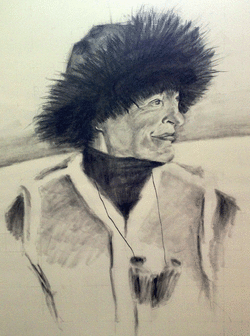 When Charlotte, NC-based artist Terri Otten peers over my shoulder at the sketch of "Tundra," she smiles slightly and comments. Interacting with museum-goers is not an unusual experience for me, as I prepare for a Sketching in the Galleries demonstration at the Greenville County Museum of Art. What is unusual: a visiting artist who specializes in portraiture. All of my insecurities surface as I pause with a #2B graphite pencil in hand. I am not a portraitist. "It certainly is a good likeness," Terri comments. Her gracious tone relaxes my pencil grip, and we exchange website information. Previously, on May 26, I presented another Sketching in the Galleries, focusing on the female in Sidney Dickinson's 1936 painting, "The Pale Rider." It is part of a traveling exhibition, Southbound, that has a limited viewing at the Museum. I sketch the entire composition, then the portraits of the two main figures, and finally concentrate on the piercing gaze of the female. Over and over again. I repeat the process for the September 22 demonstration, this time opting for Andrew Wyeth's 1993 portrait of his wife Betsy. Both selections are mine. As I struggle to capture Betsy's strong facial features, I question my choices. I find it a challenge to translate oil paint, in the case of "The Pale Rider," and watercolor and drybrush, in the case of "Tundra," into graphite on paper. It is a challenge, albeit rewarding. And it is one that I ask of my beginning drawing students. Yes, I am the instructor who places a mirror in front of each gulping student and tasks them with self portraiture. If a plaster cast of a skull is available, I will bring it to the table; all the more for understanding the armature of our human sculpture. I recommend a most intriguing book: Eye Contact: Modern American Portrait Drawings from the National Portrait Gallery, as it showcases portraiture from caricature to Impressionism to Pop. On May 26, more than 20 participants appear for the demo at the Museum, and on September 22, over 30 participate. We are all learning together at the feet of a master: Andrew Wyeth. His work is as dry as the New England landscape he portrays. Wyeth's description of Maine is quoted in the catalogue of his Metropolitan Museum of Art exhibit: "all dry bones and desiccated sinews." But, oh, how well he records those bones and sinews! Wyeth's work varies greatly from portraits by artists whose work I am inclined to study: Alice Neel, Vincent van Gogh, Berthe Morisot, Chuck Close. Alice Neel's (1900-1984) 1980 "Self Portrait" is about as honest as it gets: gravity pulls the 80 year-old's nude flesh toward the horizon line while the artist confidently raises a paintbrush in one hand and rag in the other; her silver hair is combed, her eyeglasses frame a straightforward gaze, and all this in contrast to the crisp blue-striped upholstered chair on which she sits. Neel does not slump but instead angles forward, as if toward her canvas. It is an unabashed look at reality. Her probing portraits make me squirm (not as much as Jenny Saville's), while at the same time appreciative of her artistic prowess. Similar comments can be made about Vincent Van Gogh (1853-1890). In fact, what can I say that would be "new" about his work? Perhaps this simple fact: he painted 30 self portraits between 1886-1889. He found drawing himself a worthwhile exercise in skill building. Accomplished and famous artists need to build their skills? I arrive at the conclusion that all artists need to build, or least hone their skills, and to state the obvious, we always have ourselves as available models. From the same time period as Van Gogh but less well known than her brother-in-law Edouard Manet, is the oft overlooked French Impressionist Berthe Morisot (1841-1895). Her 1885 self portrait reveals both the artist's physical beauty and beauty of brushstroke. The immediacy and energy of that captured moment is not diminished by the passage of time. Returning to the contemporary, I am fascinated by Chuck Close's continual exploration into portraiture. In 2006 I toured the Albright Knox exhibit, Chuck Close: Self-Portraits 1967–2005, which included photography, collage, printing, painting, drawing...80 works, most of a monumental scale, that constantly inquire "Who is Chuck Close?". Portraits formed of fingerprints, gridded portraits molded from paper pulp, portraits from photorealistic to conceptual. His experimentation with media still reverberates in my creative consciousness. All of this to say that, while not a portraitist, I do appreciate the genre. Drawing from life, drawing from paintings or sculpture, drawing while looking into the bathroom mirror; it's all good practice. See you around the Museum; bring your sketchpad and an Ebony pencil. 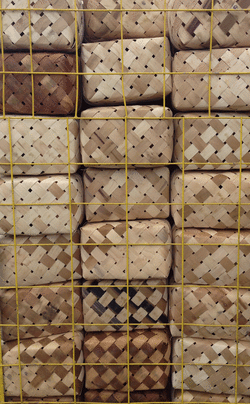 We are in the midst of an exercise during art camp when a child's voice rises above the chatter: "I love texture." So do I. The ordered bumpiness of woven baskets, the slippery sheen of silk, the halting roughness of sandpaper, the tug of thread in quilts. Later, when I stop at Fishers Orchard in Greer, South Carolina, I am struck by the texture of empty peach baskets and cannot resist a photo or two of the sculptural stacks. There are enthusiastic moments during my month-long gig as art camp instructor, for example, when a child exclaims "This is fun." There are also comical moments that define our generational gap. When I pull up a YouTube clip of TV-personality Mr. Rogers who is showcasing a film on the manufacture of crayons, a young child asks "Who is Mr. Rogers?". A slightly older child responds, "Oh, he's the guy in the sweater." I personally miss Mr. Rogers' compassion for children such as these and his tenderness with life (although his slow-as-molasses style remains slightly irritating to my Northern sensibilities). There is also an uncomfortable moment following art camp when a parent confides that her own ADHD intrudes on art time with her similarly-diagnosed offspring, because she competes for materials. Did I hear you sigh? Can you hear mine? My spouse will say that I am "processing," and indeed I am. Working with 6 to 12 year-olds is a stretch, as my usual range is 13 to 93. What I strive for is an experience that is museum quality but accessible to the 6 year-old, as well as challenging for the 12 year-old. There are the inevitable bumps and band-aids, Disney movies and snack crumbs crunching underfoot, and grateful as well as arrogant parents. Additional challenges appear in the form of special-needs children, and glue sticks. Yes, glue sticks. The kids jauntily mimic my phrase, "This is history," as they hand me the gooey remnants of tube and cap. My aim for the garbage container improves daily! Tween girls stitch for the first time during our art quilt exercise. With plastic needles and embroidery floss, they pierce the fabric with irregular novice stitches. The quilters of Gee's Bend, Alabama, are our inspiration. "I hope you love these quilts as much as I do," I exude to a rapt audience of the younger campers. Their wide eyes and an "I do" are confirmation. I struggle to explain the mechanics of the printing press and three-dimensional lead type to campers who live in a digital world. Even the YouTube segment I've located on contemporary letterpress isn't quite enough information. When one of the campers suggests that it resembles the raised type on a typewriter, I am both relieved and full of wonder. Typewriter? Where did they learn about this antiquated technology? As we proceed with our printing exercise, the kids learn that old-fashioned type really does need to be set backwards and upside down. Mind boggling even for a former typesetter (me - computer, not lead). During our time together, the campers and I look at artwork by Romare Bearden, Eric Carle, Mary Cassatt, Jim Dine, Robert Indiana, Claude Monet, Pablo Picasso, Man Ray, and Andy Warhol, to name a few. Not all of the activities focus on texture. We also delve into the worlds of collage, color, multicultural craft, and printing. But as I admire the baskets at Fishers Orchard and hear a child's voice echoing "I love texture," I discover all of my art camp moments weaving into the texture of life: bumpy, slippery, rough, tugging. |
Christina Laurel -
|

